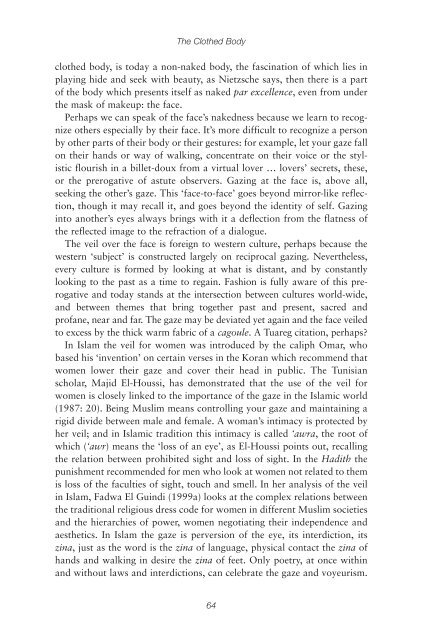Create successful ePaper yourself
Turn your PDF publications into a flip-book with our unique Google optimized e-Paper software.
<strong>The</strong> <strong>Clothed</strong> <strong>Body</strong><br />
clothed body, is today a non-naked body, the fascination of which lies in<br />
playing hide and seek with beauty, as Nietzsche says, then there is a part<br />
of the body which presents itself as naked par excellence, even from under<br />
the mask of makeup: the face.<br />
Perhaps we can speak of the face’s nakedness because we learn to recognize<br />
others especially by their face. It’s more difficult to recognize a person<br />
by other parts of their body or their gestures: for example, let your gaze fall<br />
on their hands or way of walking, concentrate on their voice or the stylistic<br />
flourish in a billet-doux from a virtual lover … lovers’ secrets, these,<br />
or the prerogative of astute observers. Gazing at the face is, above all,<br />
seeking the other’s gaze. This ‘face-to-face’ goes beyond mirror-like reflection,<br />
though it may recall it, and goes beyond the identity of self. Gazing<br />
into another’s eyes always brings with it a deflection from the flatness of<br />
the reflected image to the refraction of a dialogue.<br />
<strong>The</strong> veil over the face is foreign to western culture, perhaps because the<br />
western ‘subject’ is constructed largely on reciprocal gazing. Nevertheless,<br />
every culture is formed by looking at what is distant, and by constantly<br />
looking to the past as a time to regain. Fashion is fully aware of this prerogative<br />
and today stands at the intersection between cultures world-wide,<br />
and between themes that bring together past and present, sacred and<br />
profane, near and far. <strong>The</strong> gaze may be deviated yet again and the face veiled<br />
to excess by the thick warm fabric of a cagoule. A Tuareg citation, perhaps?<br />
In Islam the veil for women was introduced by the caliph Omar, who<br />
based his ‘invention’ on certain verses in the Koran which recommend that<br />
women lower their gaze and cover their head in public. <strong>The</strong> Tunisian<br />
scholar, Majid El-Houssi, has demonstrated that the use of the veil for<br />
women is closely linked to the importance of the gaze in the Islamic world<br />
(1987: 20). Being Muslim means controlling your gaze and maintaining a<br />
rigid divide between male and female. A woman’s intimacy is protected by<br />
her veil; and in Islamic tradition this intimacy is called ‘awra, the root of<br />
which (‘awr) means the ‘loss of an eye’, as El-Houssi points out, recalling<br />
the relation between prohibited sight and loss of sight. In the Hadith the<br />
punishment recommended for men who look at women not related to them<br />
is loss of the faculties of sight, touch and smell. In her analysis of the veil<br />
in Islam, Fadwa El Guindi (1999a) looks at the complex relations between<br />
the traditional religious dress code for women in different Muslim societies<br />
and the hierarchies of power, women negotiating their independence and<br />
aesthetics. In Islam the gaze is perversion of the eye, its interdiction, its<br />
zina, just as the word is the zina of language, physical contact the zina of<br />
hands and walking in desire the zina of feet. Only poetry, at once within<br />
and without laws and interdictions, can celebrate the gaze and voyeurism.<br />
64

















